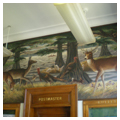Between 1938 and 1943, twenty-one artworks, of which nineteen survive, were added to Arkansas’s post offices and federal buildings. Sponsored by the Section of Fine Arts, one of President Franklin D. Roosevelt’s New Deal programs, the project gave work to struggling artists. The murals and sculptural pieces take as their subjects the state’s natural resources, industry, and history, idealizing these aspects in the goal of uplifting people in a difficult time.
Fertility is expressed in Lake County Wildlife, a mural in Lake Village’s post office that depicts a riverine landscape teeming with plants, animals, and birds. Equally rich is Henry Simon’s view of Wildlife Conservation in Arkansas in DeQueen’s post office SV1 where the landscape is abundant with various animals and fowl.
Some murals portray Arkansans at work. In Nashville, John Tazewell Robertson’s Peach Growing 1939 shows different seasons of cultivation. A sawmill is the focus of Bertrand R. Adams’s Lumbering in Arkansas 1940 for the post office in Siloam Springs. Ethel Magafan’s lyrical portrayal of Cotton Pickers 1940 in Wynne Cross County barely intimates at the back-breaking labor of the African American workers in the cotton fields. The hard work involved in the mining industry is evident in Julius Woeltz’s The Bauxite Mines 1942. Painted for the federal building in Benton, the mural has been moved to the Saline County Courthouse. Also departing from a rural theme is the painting in the post office in Piggott, Clay County. Air Mail 1941 by Daniel Rhodes pictures contemporary mail delivery with an airplane dominating the composition.
Another mural that gives a glimpse of the era is William Traher’s triptych Portrait of Contemporary DeWitt 1941 in the town’s post office. The center panel illustrates rice cultivation in the area, the left flanking panel depicts an African American neighborhood of small wooden houses and their residents, and the right panel reveals a mansion and a white family.
H. Louis Freund was the only artist who was commissioned for more than one mural in Arkansas, completing two. For the former post office in Heber Springs he painted a young pioneer couple in From Timber to Agriculture and a historical scene, Early Days and First Post Office in Pocahontas 1939 for the river town of Pocahontas. The latter mural is now in the Arkansas State University Museum in Jonesboro. Freund was head of the art department at Hendrix College in Conway from 1941 to 1946, and he and his wife, jewelry artist Elsie Bates, established the Summer Art School of the Ozarks in Eureka Springs, which operated from 1940 to 1951.
A few artworks were sculptures. Daniel Olney created Man and Woman, Arkansas 1940 in painted plaster reliefs for Berryville’s post office. Approximately three feet high, the work consists of a farmer with a sheaf of wheat, a woman with a butter churn, and, between them, a plow and a guitar, symbolizing work and play. In Monticello, three terra-cotta bas-reliefs of 1940 represent tomato culture.
Conceived in the Great Depression, the federal art program encouraged artists to create scenes that celebrated the values of community and work, while at the same time giving us a glimpse of the beauty of the state’s landscape.
Writing Credits
If SAH Archipedia has been useful to you, please consider supporting it.
SAH Archipedia tells the story of the United States through its buildings, landscapes, and cities. This freely available resource empowers the public with authoritative knowledge that deepens their understanding and appreciation of the built environment. But the Society of Architectural Historians, which created SAH Archipedia with University of Virginia Press, needs your support to maintain the high-caliber research, writing, photography, cartography, editing, design, and programming that make SAH Archipedia a trusted online resource available to all who value the history of place, heritage tourism, and learning.








